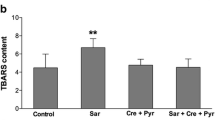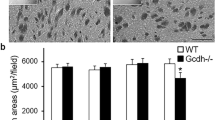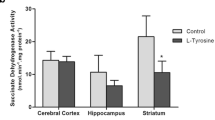Abstract
Glutaric acidemia type I (GA I) (GA I, McKusick 23167; OMIM # 231670) is an autosomal recessive metabolic disorder caused by glutaryl-CoA dehydrogenase deficiency (EC 1.3.99.7). Clinically, the disease is characterized by macrocephaly, hypotonia, dystonia and diskinesia. Since the pathophysiology of this disorder is not yet well established, in the present investigation we determined a number of energy metabolism parameters, namely 14CO2 production, the activities of the respiratory chain complexes I–IV and of creatine kinase, in tissues of rats chronically exposed to glutaric acid (GA). High tissue GA concentrations (0.6 mM in the brain, 4 mM in skeletal muscle and 6 mM in plasma) were induced by three daily subcutaneous injections of saline-buffered GA (5 μmol·g−1 body weight) to Wistar rats from the 5th to the 21st day of life. The parameters were assessed 12 h after the last GA injection in cerebral cortex and middle brain, as well as in skeletal muscle homogenates of GA-treated rats. GA administration significantly inhibited the activities of the respiratory chain complexes I-III and II and induced a significant increase of complex IV activity in skeletal muscle of rats. Furthermore, creatine kinase activity was also inhibited by GA treatment in skeletal muscle. In contrast, these measurements were not altered by GA administration in the brain structures studied. Taken together, it was demonstrated that chronic GA administration induced an impairment of energy metabolism in rat skeletal muscle probably due to a higher tissue concentration of this organic acid that may be possibly associated to the muscle weakness occurring in glutaric acidemic patients.




Similar content being viewed by others
References
Bjugstad KB, Zawada WM, Goodman S, Free CR (2001) IGF-1 and bFGF reduce glutaric acid and 3-hydroxyglutaric acid toxicity in striatal cultures. J Inherit Metab Dis 24:631–647
Brouillet E, Guyot MC, Mittoux V, Altairac S, Conde F, Palfi S, Hantraye P (1998) Partial inhibition of brain succinate dehydrogenase by 3-nitropropionic acid is sufficient to initiate striatal degeneration in rat. J Neurochem 70:794–805
da C Ferreira G, Viegas CM, Schuck PF, Latini A, Dutra-Filho CS, Wyse AT, Wannmacher CM, Vargas CR, Wajner M (2005) Glutaric acid moderately compromises energy metabolism in rat brain. Int J Dev Neurosci 23:687–693
da Silva CG, Ribeiro CA, Leipnitz G, Dutra-Filho CS, Wyse AT, Wannmacher CM, Sarkis JJ, Jakobs C, Wajner M (2002) Inhibition of cytochrome c oxidase activity in rat cerebral cortex and human skeletal muscle by D-2-hydroxyglutaric acid in vitro. Biochim Biophys Acta 1586:81–91
Das AM, Lucke T, Ullrich K (2003) Glutaric aciduria I: creatine supplementation restores creatine phosphate levels in mixed cortex cells from rat incubated with 3-hydroxyglutarate. Mol Genet Metab 78:108–111
de Mello CF, Kölker S, Ahlemeyer B, de Souza FR, Fighera MR, Mayatepek E, Krieglstein J, Hoffmann GF, Wajner M (2001) Intrastriatal administration of 3-hydroxyglutaric acid induces convulsions and striatal lesions in rats. Brain Res 916:70–75
de Oliveira Marques F, Hagen ME, Pederzolli CD, Sgaravatti AM, Durigon K, Testa CG, Wannmacher CM, de Souza Wyse AT, Wajner M, Dutra-Filho CS (2003) Glutaric acid induces oxidative stress in brain of young rats. Brain Res 964:153–158
Ferreira G da C, Viegas CM, Schuck PF, Tonin A, Ribeiro CA, de M Coelho D, Dalla-Costa T, Latini A, Wyse AT, Wannmacher CM, Vargas CR, Wajner M (2005) Glutaric acid administration impairs energy metabolism in midbrain and skeletal muscle of young rats. Neurochem Res 30:1123–1131
Fischer JC, Ruitenbeek W, Berden JA, Trijbels JM, Veerkamp JH, Stadhouders M, Sengers RC, Janssen AJ (1985) Differential investigation of the capacity of succinate oxidation in human skeletal muscle. Clin Chim Acta 153:23–36
Floret D, Divry P, Dingeon N, Monnet P (1979) Acidurie glutarique. Arch FR Pediatr 36:462–470
Flott-Rahmel B, Falter C, Schluff P, Fingerhut R, Christensen E, Jakobs C, Musshoff U, Fautek JD, Deufel T, Ludolph A, Ullrich K (1997) Nerve cell lesions caused by 3-hydroxyglutaric acid: A possible mechanism for neurodegeneration in glutaric acidaemia I. J Inherit Metab Dis 20:387–390
Freudenberg F, Lukacs Z, Ullrich K (2004) 3-Hydroxyglutaric acid fail to affect the viability of primary neuronal rat cells. Neurobiol Dis 16:581–584
Frizzo ME, Schwarzbold C, Porciuncula LO, Dalcin KB, Rosa RB, Ribeiro CA, Souza DO, Wajner M (2004) 3-hydroxyglutaric acid enhances glutamate uptake into astrocytes from cerebral cortex of young rats. Neurochem Int 44:345–353
Goodman SI, Frerman FE (2001) Organic acidemias due to defects in lysine oxidation: 2-ketoadipic acidemia and glutaric acidemia. In: Scriver CR, Beaudet AL, Sly WS, Valle D, Childs B, Kinzler KW, Vogelstein B (eds) The metabolic and molecular bases of inherited diseas, 8th edn. McGraw-Hill, New York, pp 2195–2204
Goodman SI, Markey SP, Moe PG, Miles BS, Teng CC (1975) Glutaric aciduria: a “new” disorder of amino acid metabolism. Biochem Med 12:12–21
Goodman SI, Norenberg MD, Shikes RH, Breslich DJ, Moe PG (1977) Glutaric aciduria: Biochemical and morphologic considerations. J Pediatr 90:746–750
Gregersen N, Brandt NJ (1979) Ketotic episodes in glutaryl-CoA dehydrogenase deficiency (glutaric aciduria). Pediatr Res 13:977–981
Hillered L, Ernster L (1983) Respiratory activity of isolated rat brain mitochondria following in vitro exposure to oxygen radicals. J Cereb Blood Flow Metab 3:207–214
Hoffmann GF, Zchoscke J (1999) Glutaric aciduria type I: from clinical, biochemical and molecular diversity to successful therapy. J Inherit Meatb Dis 22:381–391
Hughes BP (1962) A method for the estimation of serum CK and its use in comparing creatine kinase and aldolase activity in normal and pathological sera. Clin Chim Acta 7:597–603
Koeller DM, Woontner M, Crnic LS, Kleinschmidt-DeMasters B, Stephens J, Hunt EL, Goodman SI (2002) Biochemical, pathologic and behavioral analysis of a mouse model of glutaric acidemia type I. Hum Mol Genet 11:347–357
Kölker S, Garbade SF, Greenberg CR, Leonard JV, Saudubray JM, Ribes A, Kalkanoglu HS, Lund AM, Merinero B, Wajner M, Troncoso M, Williams M, Walter JH, Campistol J, Marti-Herrero M, Caswill M, Burlina AB, Lagler F, Maier EM, Schwahn B, Tokatli A, Dursun A, Coskun T, Chalmers RA, Koeller DM, Zschocke J, Christensen E, Burgard P, Hoffmann GF (2006) Natural history, outcome, and treatment efficacy in children and adults with glutaryl-CoA dehydrogenase deficiency. Pediatr Res 59:840–847
Kölker S, Ahlemeyer B, Huhne R, Mayatepek E, Krieglstein J, Hoffmann GF (2001b) Potentiation of 3-hydroxyglutarate neurotoxicity following induction of astrocytic iNOS in neonatal rat hippocampal cultures. Eur J Neurosci 13:2115–2122
Kölker S, Ahlemeyer B, Krieglstein J, Hoffmann GF (1999) 3-Hydroxyglutaric and glutaric acids are neurotoxic through NMDA receptors in vitro. J Inherit Metab Dis 22:259–262
Kölker S, Ahlemeyer B, Krieglstein J, Hoffmann GF (2001a) Contribution of reactive oxygen species to 3-hydroxyglutarate neurotoxicity in primary neuronal cultures from chick embryo telencephalons. Pediatr Res 50:76–82
Kölker S, Hoffmann GF, Schor DS, Feyh P, Wagner L, Jeffrey I, Pourfarzam M, Okun JG, Zschocke J, Baric I, Bain MD, Jakobs C, Chalmers RA (2003) Glutaryl-CoA dehydrogenase deficiency: region-specific analysis of organic acids and acylcarnitines in post mortem brain predicts vulnerability of the putamen. Neuropediatrics 34:253–260
Kölker S, Okun JG, Ahlemeyer B, Wyse AT, Horster F, Wajner M, Kohlmuller D, Mayatepek E, Krieglstein J, Hoffmann GF (2002) Chronic treatment with glutaric acid induces partial tolerance to excitotoxicity in neuronal cultures from chick embryo telencephalons. J Neurosci Res 68:424–431
Külkens S, Harting I, Sauer S, Zschocke J, Hoffmann GF, Gruber S, Bodamer OA, Kölker S (2005) Late-onset neurologic disease in glutaryl-CoA dehydrogenase deficiency. Neurology 64:2142–2144
Latini A, Borba Rosa R, Scussiato K, Llesuy S, Bello-Klein A, Wajner M (2002) 3-Hydroxyglutaric acid induces oxidative stress and decreases the antioxidant defenses in cerebral cortex of young rats. Brain Res 956:367–373
Latini A, Scussiato K, Leipnitz G, Dutra-Filho CS, Wajner M (2005) Promotion of oxidative stress by 3-hydroxyglutaric acid in rat striatum. J Inherit Metab Dis 28:57–67
Lima TT, Begnini J, de Bastiani J, Fialho DB, Jurach A, Ribeiro MC, Wajner M, de Mello CF (1998) Pharmacological evidence for GABAergic and glutamatergic involvement in the convulsant and behavioral effects of glutaric acid. Brain Res 802:55–60
Lowry OH, Rosebrough NJ, Farr AL, Randall RJ (1951) Protein measurement with the Folin phenol reagent. J Biol Chem 193:265–275
Lund TM, Christensen E, Kristensen AS, Schousboe A, Lund AM (2004) On the neurotoxicity of glutaric, 3-hydroxyglutaric, and trans-glutaconic acids in glutaric acidemia type I. J Neurosci Res 77:143–147
Melov S, Coskun P, Patel M, Tuinstra R, Cottrell B, Jun AS, Zastawny TH, Dizdaroglu M, Goodman SI, Huang TT, Miziorko H, Epstein CJ, Wallace DC (1999) Mitochondrial disease in superoxide dismutase 2 mutant mice. Proc Natl Acad Sci USA 96:846–851
Mordekar SR, Guthrie P, Bonham JR, Olpin SE, Hargreaves I, Baxter PS (2006) The significance of reduced respiratory chain enzyme activities: Clinical, biochemical and radiological associations. Eur J Paediatr Neurol 10:78–82
Nagy ZS, Esiri MM, LeGris M, Matthews PM (1999) Mitochondrial enzyme expression in the hippocampus in relation to Alzheimer-type pathology. Acta Neuropathol 97:346–354
Porciuncula LO, Dal-Pizzol Jr A, Coitinho AS, Emanuelli T, Souza DO, Wajner M (2000) Inhibition of synaptosomal [3H]glutamate uptake and [3H]glutamate binding to plasma membranes from brain of young rats by glutaric acid in vitro. J Neurol Sci 73:93–96
Rafique R, Schapira AH, Cooper JM (2001) Sensitivity of respiratory chain activities to lipid peroxidation: Effect of vitamin E deficiency. Biochem J 357:887–892
Rosa RB, Schwarzbold C, Dalcin KB, Ghisleni GC, Ribeiro CA, Moretto MB, Frizzo ME, Hoffmann GF, Souza DO, Wajner M (2004) Evidence that 3-hydroxyglutaric acid interacts with NMDA receptors in synaptic plasma membranes from cerebral cortex of young rats. Neurochem Int 45:1087–1094
Rustin P, Chretien D, Bourgeron T, Gérard B, Rötig A, Saudubray JM, Munnich A (1994) Biochemical and Molecular investigations in respiratory chain deficiencies. Clin Chim Acta 228:35–51
Sauer SW, Okun JG, Fricker G, Mahringer A, Muller I, Crnic LR, Muhlhausen C, Hoffmann GF, Horster F, Goodman SI, Harding CO, Koeller DM, Kolker S (2006) Intracerebral accumulation of glutaric and 3-hydroxyglutaric acids secondary to limited flux across the blood-brain barrier constitute a biochemical risk factor for neurodegeneration in glutaryl-CoA dehydrogenase deficiency. J Neurochem 97:899–910
Sauer SW, Okun JG, Schwab MA, Crnic LR, Hoffmann GF, Goodman SI, Koeller DM, Kölker S (2005) Bioenergetics in glutaryl-coenzyme A dehydrogenase deficiency: a role for glutaryl-coenzyme A. J Biol Chem 280:830–836
Schapira AH, Mann VM, Cooper JM, Dexter D, Daniel SE, Jenner P, Clark JB, Marsden CD (1990) Anatomic and disease specificity of NADH CoQ1 reductase (complex I) deficiency in Parkinson's disease. J Neurochem 55:2142–2145
Schuck PF, Leipnitz G, Ribeiro CA, Dalcin KB, Assis DR, Barschak AG, Pulrolnik V, Wannmacher CM, Wyse AT, Wajner M (2002) Inhibition of creatine kinase activity in vitro by ethylmalonic acid in cerebral cortex of young rats. Neurochem Res 27:1633–1639
Silva CG, Silva AR, Ruschel C, Helegda C, Wyse AT, Wannmacher CM, Dutra-Filho CS, Wajner M (2000) Inhibition of energy production in vitro by glutaric acid in cerebral cortex of young rats. Metab Brain Dis 15:123–131
Strauss KA, Morton DH (2003) Type I glutaric aciduria, part 2: A model of acute striatal necrosis. Am J Med Genet 121:53–70
Strazielle C, Sturchler-Pierrat C, Staufenbiel M, Lalonde R (2003) Regional brain cytochrome oxidase activity in b-amyloid precursor protein transgenic mice with the Swedish mutation. Neuroscience 118:1151–1163
Ullrich K, Flott-Rahmel B, Schluff P, Musshoff U, Das A, Lucke T, Steinfeld R, Christensen E, Jakobs C, Ludolph A, Neu A, Roper R (1999) Glutaric aciduria type I: Pathomechanisms of neurodegeneration. J Inherit Metab Dis 22:392–403
Zhang Y, Marcillat O, Giulivi C, Ernster L, Davies KJ (1990) The oxidative inactivation of mitochondrial electron transport chain components and ATPase. J Biol Chem 265:16330–16336
Acknowledgments
We are grateful to the financial support of CNPq, PRONEX, FAPERGS and PROPESQ/UFRGS.
Author information
Authors and Affiliations
Corresponding author
Rights and permissions
About this article
Cite this article
Ferreira, G.d.C., Schuck, P.F., Viegas, C.M. et al. Energy Metabolism is Compromised in Skeletal Muscle of Rats Chronically-Treated with Glutaric Acid. Metab Brain Dis 22, 111–123 (2007). https://doi.org/10.1007/s11011-006-9043-0
Received:
Accepted:
Published:
Issue Date:
DOI: https://doi.org/10.1007/s11011-006-9043-0




